|
What's in the box this week
~~~~~~~~~~~~~~~~~~~~~~~~~~~~~~~~~~~~~~~~~~~~~~~~
Content differences between Family and Small
Shares are in red; items
with a "+" in
Family Shares are more in quantity than in Small; anticipated quantities, if
any, are in parentheses, as is the source of any produce not from Live Earth
Farm (LEF). Occasionally content will differ
from this list (typically we will make a substitution), but we do our best to
give you an accurate projection.
[go to recipe database]
Family Share
Fuji apples (10)
Small artichokes (Swanton Berry Farm)
Arugula
Red Forono beets, with tops
Baby broccoli (Lakeside)
Chantenay carrots
Chard
Green garlic
Leeks
Romaine lettuce (Lakeside)
Radishes
Baby tatsoi +
one basket of strawberries... maybe!
Small Share
Fuji apples (6)
Arugula
Baby broccoli (Lakeside)
Cabbage (red or green)
Chantenay carrots
Chard
Leeks
Romaine lettuce (Lakeside)
Red radishes
Baby tatsoi
Extra Fruit and Fruit Bounty Options
(remember: fruit options don't begin until May)
Bread
This week's bread will be whole wheat with flax seed
|
Everyone is catching the Springtime Buzz; we are busy, busy, busy bees!
~~~~~~~~~~~~~~~~~~~~~~~~~~~~~~~~~~~~~~~~~~~~~~~~  Today will be the last warm day for a while; the week ahead is forecast to be unsettled and much cooler. We are busy trying to stay ahead with our fieldwork. These last few of weeks, the spring weather and the start of the CSA season has jolted our entire operation into overdrive. Work starts at 6:30 or 7am and ends, for many of us, when the sun goes down. Besides sowing, planting, weeding, picking and harvesting, the entire irrigation system is being set up in preparation for the drier months ahead. That means, all the pumps and valves have to be tested, sprinkler pipe repaired and flushed out, and drip irrigation lines rolled out and reconnected, especially for strawberries and caneberries (caneberries include both raspberries and blackberries). Even in some of the new fields we are trenching to install new supply lines. Our tractors continue mowing, plowing, spreading compost, fertilizing, and listing and shaping beds for the many plantings scheduled throughout the month of April. Over the last few years my camera has been a useful tool for recording life on the farm. So pictures will do most of the talking this week, since it's been a bit difficult sitting still to reflect and write. Today will be the last warm day for a while; the week ahead is forecast to be unsettled and much cooler. We are busy trying to stay ahead with our fieldwork. These last few of weeks, the spring weather and the start of the CSA season has jolted our entire operation into overdrive. Work starts at 6:30 or 7am and ends, for many of us, when the sun goes down. Besides sowing, planting, weeding, picking and harvesting, the entire irrigation system is being set up in preparation for the drier months ahead. That means, all the pumps and valves have to be tested, sprinkler pipe repaired and flushed out, and drip irrigation lines rolled out and reconnected, especially for strawberries and caneberries (caneberries include both raspberries and blackberries). Even in some of the new fields we are trenching to install new supply lines. Our tractors continue mowing, plowing, spreading compost, fertilizing, and listing and shaping beds for the many plantings scheduled throughout the month of April. Over the last few years my camera has been a useful tool for recording life on the farm. So pictures will do most of the talking this week, since it's been a bit difficult sitting still to reflect and write.
- Tom
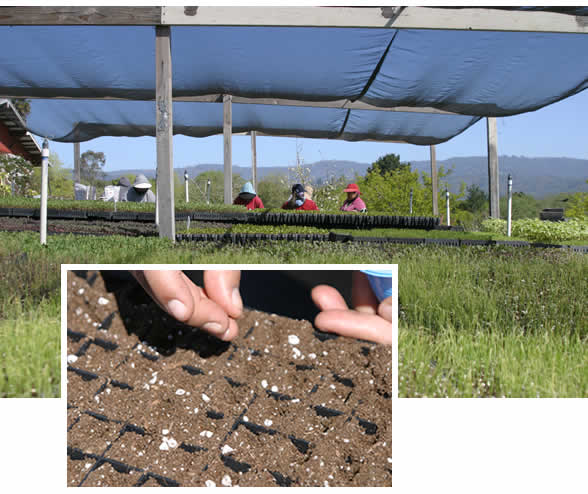
Here, the women sow seeds outside the greenhouse under the shade cloth.
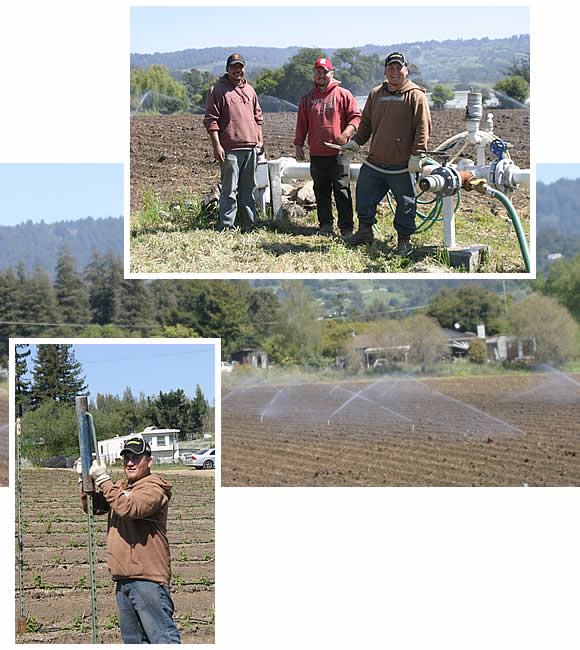
Above right, our crack irrigation team: Clemente, Johnny and Angel. In-between the management of field irrigation, they take on other needed business. At left Angel is pounding in a stake for a new raspberry patch - these three guys hammered in about 400 stakes on 2 1/2 acres over 2 days. That's a lot of work!
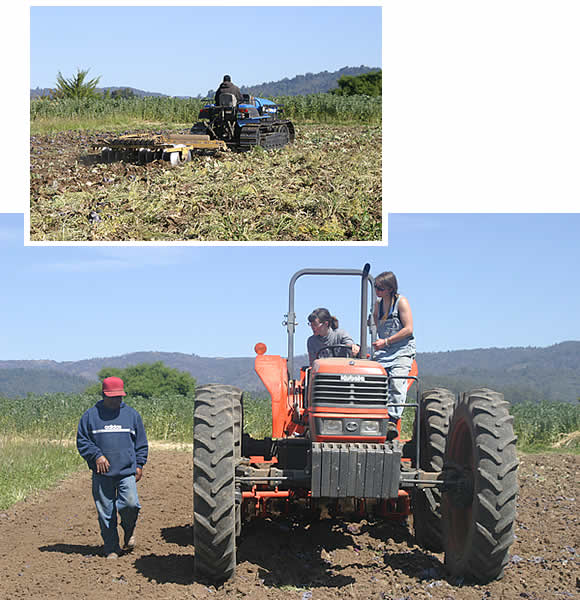
At top, Ruben disks a field; and here, Juan works with two of this year's interns, Molly and Taylor, teaching them how to operate the tractor with the spader attachment.
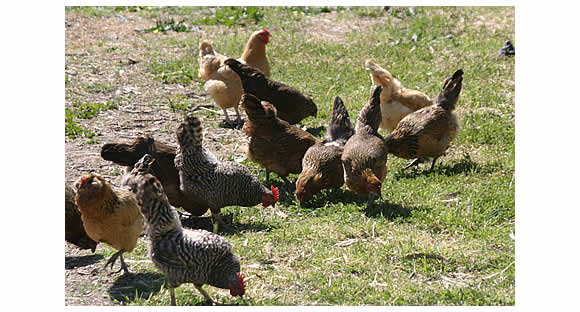
And we'll end with a gratuitous happy chicken shot! The chickens are let out of their enclosure every afternoon to run around and do chicken things. They return to the coop at dusk all on their own, and Taylor closes the door to keep them safe from predators.
|
Is our emerging Local Food System under threat? I think so!~~~~~~~~~~~~~~~~~~~~~~~~~~~~~~~~~~~~~~~~~~~~~~~~ Many members have brought to our attention and asked with concern how a recently proposed Food Modernization Act, also known as HR 875, might affect local and small-scale organic farms like ours. I get my information from speaking to other farmers, and from organizations that are at the forefront, defending the interests of the sustainable farming and food community. I am no expert reading and analyzing legislation, but when I did get a chance to read the actual bill - especially the definitions and Section 206 - I am worried that small growers and producers would be especially hard hit. I am not sure I agree with many of the outlandish rumors currently floating around the internet, but given the mistrust I have in our legislative process, which tends to cater to and support the greedy agribusiness interests, I am happy there is such a quick and strong response against this bill. The reviews I recommend reading come from the Organic Consumer Association, Farm-to-Consumer Legal Defense Fund, and Cornucopia Institute all of which are advocating food safety to focus on the real threats such as un-inspected imports from overseas, lax inspections of massive slaughterhouses as well as large factory farming and processing operations. New laws should explicitly exempt small farmers and reduce the bureaucratic and regulatory burden on them. The bill leaves too much at the discretion of government agencies, giving them broad powers that can easily be abused. Please make your voices heard; HR 875, disguised as a Food Safety Bill, can easily wreak havoc with all of our hard-earned sustainable agriculture efforts and budding local food systems. - Tom
|
Your donated shares may be tax deductible~~~~~~~~~~~~~~~~~~~~~~~~~~~~~~~~~~~~~~~~~~~~~~~~ If you ever ask me to donate your share for you, here's what happens: First, I redirect your share that week to our pick-up site on the farm, and then we have a couple wonderful members who have generously volunteered their time to take turns shuttling them to Loaves & Fishes here in Watsonville. (This is no small task, especially in the summer when folks go on vacation ~ we've had 10 or more donated shares a week sometimes!!) Loaves & Fishes is a 501(c)3 charity, and its executive director, Patricia Morales told us that if you contact her and provide your name, mailing address and how many shares you donated (and the value of those shares - see Cost on our website), she is more than happy to send you a donation letter at the end of the year for your records. But you must make sure I received your instructions and that the share was actually donated (some folks don't give me enough notice and then I can't arrange it): best way to verify this is to make your request via email. If you get a reply from me saying I will take care of it, then it will be donated. If you have more questions, feel free to email Patricia directly at loavesandfishes@cruzio.com - Debbie
|
This week's artichokes...~~~~~~~~~~~~~~~~~~~~~~~~~~~~~~~~~~~~~~~~~~~~~~~~ 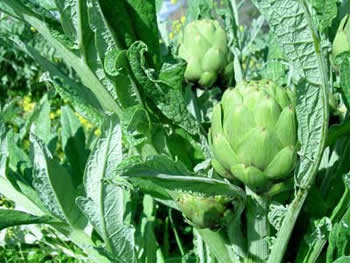 The artichokes in your share this week * are from Swanton Berry Farm, in Davenport (along the coast, just north of Santa Cruz). Bill Kennedy from Swanton says, "They are the 'Globe' variety, perennials regenerated from stock originally brought over from Italy perhaps 100 years ago. They are recognizable by their thicker leaves, large meaty hearts, and outstanding flavor, distinguishable from the newer seeded varieties that, although easier to grow and more perfectly shaped, have thin leaves, small hearts, and less flavor. Our Globe artichokes favor the Mediterranean climate of the central California coast, and the peak growing period is approximately mid-March through mid-May." These artichokes are going to be incredibly fresh, too, as they are being harvested and delivered to us Tuesday, then going into your shares Wednesday and Thursday. None of this sitting-on-the-shelf-in-the-produce-aisle-for-an-unknown-length-of- time business! Also, these will be smaller artichokes, fist-sized down to egg-sized, or so-called 'baby' artichokes. Now baby artichokes are not immature, they're actually fully mature artichokes that just happen to be small in size. But no matter their size nor how you cook them, artichokes are "very healthy as well as tasty. They are a good source of vitamin C, folate, fiber and a number of minerals especially potassium, phosphorus and magnesium." [excerpted from an online blog called 'Cooking with Amy'] - Debbie * Note that because we can only get a limited quantity of chokes from Swanton each week, we're going to divide them up, i.e. the Family shares will get artichokes this week, and the Small share will get them next week.
|
|
How to ensure you always get our emails
~~~~~~~~~~~~~~~~~~~~~~~~~~~~~~~~~~~~~~~~~~~~~~~~
Periodically I get messages from alarmed members who claim they did not receive something important I emailed them. As I do 99% of my communicating with members via email, this is an important concern. However, there is a solution: most mail programs these days have something called "Rules" or "Filters", which are options you can configure to control what email you receive, and how you receive it. So the best way to ensure you always get my emails is to set a rule/filter that 'always accepts emails that contain (NOT "equals") the words "Live Earth Farm" in the subject line'. I always preface the subject line of emails that originate from the farm with the words "Live Earth Farm", followed by something. Set that rule/filter, and you should be fine.
Also keep in mind that, if you tend to have a lot of email to wade through and miss stuff that way, you can always search on the word string "Live Earth Farm" as well, and that will float farm emails to the top of your list! - Debbie
|
Notes from Debbie's Kitchen
~~~~~~~~~~~~~~~~~~~~~~~~~~~~~~~~~~~~~~~~~~~~~~~~ Click here to go to recipe database.
How'd everybody do last week? Got several happy emails from enthusiastic members (always appreciated!), so I'm guessing so-far-so-good! And before I forget - again, I'm addressing you new members - I love getting your recipes, cooking ideas and photos, so please, if you made something and were particularly chuffed with yourself about how it turned out, send me your story so I can share it with the rest of us. Or if you just have a favorite recipe to which you add your own twist, that's great too. It's the crux of cooking with a CSA box; how to make meals and feed your family in a healthy and pleasurable way every day. Cooking doesn't need to be elaborate or complicated - especially when the ingredients are so very fresh; there's so much flavor inherent in the produce itself, it often only needs simple treatment to make it sing. I'm not saying elaborate can't be fun and satisfying in its own right, but I like to save that for special occasions. Here, it's all about the joy of eating well every day. - Debbie
First, a little info on a few of the new items in this week's box:
Green garlic vs leeks - how to tell them apart
(excerpted from a 2006 newsletter) This still stumps people, and it is easy to see why. They look so similar! Okay, that's an understatement; the leeks and green garlic are undistinguishable visually*. The green leaf of both garlic and leeks form the same "V" shape when cut crosswise, and the leaves of both have a kind of left-right branching structure, so that's no help either. You have to use your nose. Scratch 'n' sniff. The green garlic will smell like garlic. But take comfort in the fact they are both in the same family (the alliums), so in a lot of cases if you accidentally ended up using 'the wrong one' in a recipe [potato-green garlic soup instead of potato-leek soup, for example], it is not like you will suddenly have something inedible! It may be different, but will taste just fine.
*Tom plans on bunching the green garlic, which will only be in the Family Shares this week; the leeks will be loose inside the box, like last week.
The other thing to know about cooking with green garlic is that in this stage, it is quite mild, so you can chop or slice up and use a lot more green garlic proportionally in a recipe than you might if you were using the mature cloves. And you can go pretty far up into the light-to-middle green portion of the stalk, you just don't use the dark green leaf-parts which branch away from the main stalk (you can trim them away and use the inner stalk, however).
the baby Tatsoi
Tom says the leaves will be small and tender, perfect for adding to salads. Pretty too! If you're going to cook with them, I'd only just barely cook them; throw them into whatever you're cooking at the last moment, just 'til they wilt. When small like this (I'm taking Tom at his word; I haven't seen them yet myself!) ;-) they're also great for garnishing all sorts of things, soups, meats, polenta, you name it.
the artichokes!
[Small-share members, hang onto this info; you'll get yours next week!]
These are likely going to be smaller sized, as I talked about above, and so you may not have to prepare them the same as their larger versions, which require scooping out the fuzzy inner 'choke' (among other things). If they're big enough and you want to prepare them more traditionally, read my preparation tips from 2006, and favorite way to serve them, from 2004.
If they are indeed the smaller ones (egg-sized), you can prep then steam or boil them whole and, more importantly, eat them whole! (They also take less time to cook.) Preparation generally involves peeling off outer leaves until you reach the paler green inner core. Then with a sharp knife, trim off the top half-inch or so (to take away those spiny leaf-tips!) and the bottom of the stem. At this point, drop them into a bowl of acidulated water (water with lemon juice or a little vinegar in it) to keep them from browning while you prepare the rest. Best way to cook them at this point is to steam them (which helps preserve their nutrient content); they're done when a toothpick or sharp knife tip easily pierces the base. Don't overcook them though; you don't want mush!
Here are options for steaming or roasting baby artichokes (gleaned from various sources on the internet):
Steamed Baby Artichokes
Aarrange prepared artichokes in a steamer insert or basket in a pot deep enough to keep them above water (if any are a little bigger than the others, you can cut them in half). Cover tightly and steam over rapid boiling water (making sure to maintain the water level), until tender. Depending on size and quantity of artichokes you are cooking, steaming time can range from 15 to 20 minutes. Lift out carefully and drain.
Roasted Baby Artichokes
Once prepped, cut the larger artichokes in half, but if they are really small leave them whole. Place the artichokes in a pot of water to cover. Simmer artichokes for about seven or eight minutes or until tender, then drain them well. [Or, steam them as described above.] When cooled slightly toss them in olive oil and bake in a foil lined glass or metal baking dish, in a single layer, in a 400 degree oven for seven or eight minutes. Sprinkle with salt and pepper to taste. Serve warm.
You could also do many things with your steamed or roasted artichokes, sort of like you might with artichoke hearts, such as quarter them and toss into a pasta dish, put them on top of your own homemade pizza, or ?? Remember, cold, left-over cooked chokes are good too, with a little mayo infused with lemon juice... mmmmmmm.
Speaking of contributed recipes and photos, here are both from new member Cheryl Toth, who says she made this on the advice of a chef-friend, and used 3 items from last week (beets, carrots, sprouts). She says the infused balsamic was local too (from Campbell), but if you don't happen to have it, a regular balsamic will do just fine. And although we're not getting sprouts this week, as you can see by the photo, the color with the added green is marvelous... so if it were me, rather than skip the recipe 'cuz I didn't have sprouts, I'd just pick a compelling green substitute from what's in the box... like... arugula! Or, those lovely baby tatsoi leaves!!
Beets and Carrots a la Chef John
from Cheryl Toth
serves 4 adults
5 small red beets
8 - 10 small carrots (heirloom variety is best)
3- 4 handfuls of large sprouts (not alfalfa) [or a handful of small arugula or tatsoi leaves]
Balsamic infused with cinnamon and pear (or another aged balsamic of your choice)
Scrub then chop off tops and bottoms of beets. Place beets about one inch apart, on large piece of foil. In between each beet, place two slivers of butter. Salt and pepper the whole thing, wrap it up, and bake at 350 for about 1.5 hours or until the beets are cooked but not mushy. Cool and slip off skins.
Peel then cut carrots into square-ish chunks and drop into boiling water for about 5 minutes to semi cook. Remove and cool. Sauté carrots for about 10-15 minutes in olive oil with salt, pepper, about a handful of brown sugar and ¼ tsp. cinnamon, until syrupy. 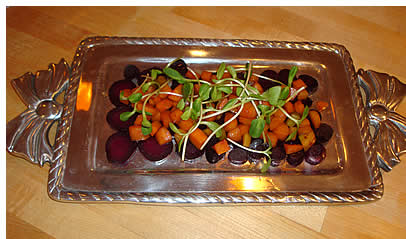
Using a mandolin or sharp knife, slice beets thinly and arrange on a serving plate 'carpaccio style.' Mound carrots on top, and top with sprouts.
Drizzle all with balsamic and serve.
Here's another contribution, this one from member Jennifer Black, who says, "this is a quick way to use apples. We also use this treatment for cucumbers, or a mixture of cucumbers & jicama, or jicama and oranges or melon slices." I love the sound of this one - zippy!!
Quick Apple Salad
by Jennifer Black
Allow about 1/2 to 1 apple per person. Core the apples, then slice or chop into pieces and place in individual serving bowls. Squeeze lime or lemon juice over the pieces and salt lightly. Then sprinkle with the hot pepper of your choice - cayenne is a good option, or you can use New Mexico chile powder, chile piquin, or whatever you generally keep on hand, in an amount that matches your taste buds. The result is quick and refreshing.
And one more contribution, this one from member Jennifer Dadek. I like her thorough explanations...
Hitchhikers Palak Paneer
Jennifer says, "I thought I'd share a recipe I got from a friend last year. This is just wonderful. My husband usually HATES Vegetarian dishes (but he loves this one), and my (turning picky) kids eat it too. It calls for spinach, but I've used whatever greens are in the box in any given week and it's just fabulous! This recipe sounds really involved, but actually goes together fairly quickly. If I can't find paneer, I get a pound of whole milk ricotta, spread it out into an 8x8 baking dish and bake at 350 until its brown and all the water has boiled off - minimum of half hour; keep checking every ten minutes after the first half hour. You want it pretty solid and cut-able."
General guidelines
1. Mise en place. Seriously. Get everything assembled before you turn the fire on.
2. Cooking is way more forgiving than baking in terms of variations in measurement, so don't stress about getting everything exact.
3. A deep-sided frying pan works best, I've found.
4. Technically, you're supposed to pass the spinach through a blender, but I've done it using fine chopped frozen spinach and it's come out fine too.
Quantities
I'm giving you quantities from the recipe that sounded closest to the one I usually make (I do it by feel, which is horrible for trying to tell other people quantities):
15 oz paneer (substitute ricotta, as described above)
10 oz spinach, frozen chopped (or any greens from the CSA box)
1/4 lg. onion, finely chopped
1/4 C sour cream (you could use yoghurt instead)
1" piece of fresh ginger
1 garlic clove [or chop up some green garlic from the box! - Debbie]
1 tsp. ground cumin
1/2 tsp. ground coriander
1/2 tsp. turmeric
1/2 tsp. chili powder
1/8 C [= 2 tbsp.] oil (or more depending on the size of your pan)
salt to taste
Preparation
1. Grate the ginger
2. Chop the onion finely
3. Put the garlic through the press [or finely chop green garlic]
4. Thaw the spinach, give it a few seconds in a blender if you have one otherwise just chop it up finely [or prepare beet greens, chard or kale as I described last week, then finely chop - Debbie]
5. Measure out the cumin, coriander, turmeric and chili powder into a small bowl or something (it's easier than frantically measuring out half-teaspoons into a sputtering pan)
6. Cut the paneer into cubes
7. Have a slotted spoon handy - you'll need this for the first bit
Cooking
1. Heat the oil in the pan. When it is hot, add the paneer and brown it lightly
2. Remove the paneer (see? told you you'd need the slotted spoon) to a holding container, sprinkle lightly with salt
3. Toss in the onion, garlic and ginger. Fry till the onions turn a translucent golden brown. Marvel at how good your kitchen smells
4. Add the spice powder mix to the onions. Turn heat down a bit, fry for 30-45 seconds, stirring continuously (basically don't let the spices stick to the pan and burn)
5. Add the sour cream and spinach [or other greens], mix everything up thoroughly, fry stirring continuously for another 30 seconds or so
6. Add the paneer, and about 1/2 cup of water, and salt to taste
7. Cover and let simmer on low heat for 15 minutes
Serve over rice.
This next recipe is one I am borrowing (with implied permission) from our friends and 'coop-etition' (as we like to call each other), Two Small Farms CSA, from their April 1 newsletter (I'm on their mailing list, and they're on ours, so we poach good-naturedly from each other; we're all in this together, after all!). Like us, they get regular submissions from their members. This is from their member, Kalyani ~
Mung dal with radishes
"Yellow mung beans (the green ones with the skins removed) easily cook down into a mellow golden puree. But we add diced radishes to the cooking beans, and they cook into buttery soft little cubes." - Kalyani
½ C mung dal (yellow, halved, not the green ones used for sprouting)
1 inch ginger, grated
½ tsp. black mustard seeds
½ tsp. cumin seeds
Juice of one lemon or lime
1 tsp. sugar (preferably brown)
1 tbsp. ghee or vegetable oil
½ tsp. salt
½ hot pepper (Serrano or jalapeno), minced
3-4 radishes, diced into small cubes
Place the mung dal and radishes in a heavy sauce pan, cover with water and simmer until cooked (about 20 minutes, the dal will break down into a smooth yellow puree when stirred.)
Take the smallest pan you have, and heat the ghee or oil. Add the cumin and mustard seeds, and sauté until the cumin is darkened. Add the ginger and pepper and stir for half a minute. Add the sugar and stir until sugar is caramelized and dark. Pour onto the cooked dal. Add the lemon juice and salt and serve hot with steamed rice, optionally topped with your favorite chutney.
And lastly, since we're getting romaine lettuce again, thought I'd give you my standby Caesar salad recipe:
Debbie's Caesar Salad
serves 2 to 4 (2 really big salads, or 4 more modest-sized ones)
Mind you, I don't measure my ingredients, so these are approximations. You can just eyeball them, no need to precisely measure!
1 head of romaine
1 small garlic clove, crushed
a dab (~ ½ tsp) Dijon mustard
a splash (~ ½ tsp) Worcestershire sauce
a squirt (1 to 2 inches long) of anchovy paste
a squeeze of juice (~ 1 tsp.) from a fresh lemon
a little white (or similar) vinegar (~ 1 tsp.)
about 2 tbsp. olive oil
pepper grinder (standing by)
a chunk of fresh parmesan, for grating (also standing by)
homemade croutons (optional - see below)
additional anchovies (optional)
I prepare romaine by removing any outer discolored leaves, and, if the head appears nice and clean (peek at the base of some of the outer leaves), chopping the whole head (minus the base) and tossing it all into a big bowl. If there's dirt or bugs, separate and wash the leaves, being sure to spin dry *well* and wrap in a clean towel (you don't want wet leaves!) before chopping.
To dress the salad, combine all the ingredients from garlic through olive oil in a small cup or bowl and whisk with a fork (I use an old teacup). Pour this over the chopped romaine and toss well to coat. Grate a bunch of fresh black pepper over all and toss again, adding more to taste (some folks like more pepper than others). Grate a bunch of fresh parmesan into it all, toss again.
Serve with optional croutons and additional anchovies if you're an anchovy lover (mmm!). I like to make Caesar when I'm making homemade pizza, so I can use the pizza crust to mop the dressing from the bowl... yum!
To make croutons, cube up some bread, toss with olive oil to coat, sprinkle with a little salt and a little dry basil (rubbed between your fingers to make into a fine powder). Spread on a cookie sheet and bake in a medium oven or toaster oven (~350 degrees) until lightly browned and crispy, maybe 5-10 minutes (check on them; you don't want 'em to burn, but you don't want 'em soft either!). Cool and store in a ziploc bag or jar or whatever.
|
|
2009 CALENDAR
~~~~~~~~~~~~~~~~~~~~~~~~~~~~~~~~~~~~~~~~~~~~~~~~
Here is the current schedule, and we will update the calendar here in the newsletter regularly. You can also get more information from the calendar on our website.
NEW!! Farm Workshops/Lectures
this is an idea that is still forming...
Possible subjects to include Permaculture, Fermented Foods, Farming with
the Wild... stay tuned!
NEW!! Community Farm Days
Every 4th Saturday of the month from May through October, 9am - 4pm
Participants are welcome to arrive Friday evening and camp out overnight
to Saturday. Please leave
your dogs at home, thanks! The intent of Community Farm Days is
to increase the opportunity for members and their families to experience and
enjoy a slice of "life
on the farm" at different times of the year - kind of like our old
Mini Camp, but for members of all ages! Each month will have a different activity
focus, and will be announced in advance here in the newsletter.
'Healthy Cooking' workshop
Saturday April 18th (see blurb in Winter Week 8 newsletter)
Apricot U-Pick Days
two Sundays: July 5th and July 12th
Bring your own bags.
Summer Solstice Celebration
Saturday June 20th <---note new date!
[click here for a short YouTube video of our 2007 celebration]
*** Children's Mini-Camp has been discontinued, and is being replaced with the above-mentioned Community Farm Days. ***
Fall Harvest Celebration
Saturday October 24th
[and click here for a YouTube video of our Fall celebration!]
|
|